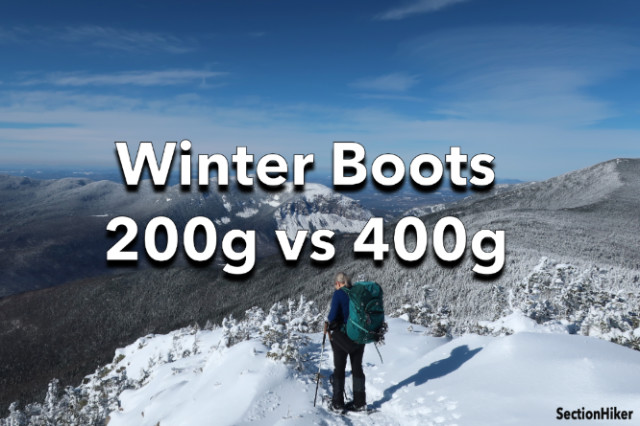
Winter boots are usually insulated with 200g or 400g synthetic insulation which is very thin but warm. The insulation varies but is usually Thinsulate, Primaloft, or a comparable synthetic fill or fiber. In addition, winter boots are almost always waterproof with waterproof/breathable liners, allowing them to be used in rain and in mud as well as on frozen surfaces.
While it’s confusing, the 200g and 400g measures don’t reflect the weight of the insulation in grams in the boots, but its thickness. For example, a 200g insulated boot doesn’t have 200 grams of insulation (which would make the boots quite heavy) but contains insulation that weighs 200 grams per square meter. A square meter is over 10.7 square feet, which is far larger than the amount of insulation contained in a single boot or a pair of insulated boots.
A 400g insulated winter boot is twice as warm as a 200g boot, meaning that it traps twice as much of the body heat produced by your feet and lower legs. In terms of temperature, a 200g insulated winter boot will keep your feet warm down to about 0-10 degrees (F), while a 400g winter boot will keep them warm down to -20 degrees (F) and possibly lower. Generally speaking, you can wear a pair of 200g winter boots in 20-30 degree Fahrenheit temperatures quite comfortably. This makes them an attractive footwear option for hiking in colder autumn temperatures before the snow has fallen. Note: All winter boot temperature ratings assume you are walking briskly and not standing around.
Another key difference between 200g and 400g winter boots is how high they extend up your leg. Most 200g winter boots are over-the-ankle, so-called”Mid” height, while 400g winter boots extend higher up your leg to mid-calf. This lets them retain more body heat, so your feet stay warmer. There are a few exceptions to this, but that’s the norm.
Recommended 200g and 400g winter boots (2022-2023)
Winter Footwear Systems
If you’re planning on hiking or snowshoeing in winter, it’s important to realize that insulated boots are really just one part of the multi-part winter footwear system. You’ll also want to wear:
- a pair of warm socks
- gaiters
- insulated insoles
- winter traction devices like microspikes, crampons, or snowshoes
Winter Socks
Different people have different preferences when it comes to winter socks; some like to wear sock liners in addition to a warm sock, while others prefer a single sock. We like Darn Tough’s merino wool hiker boot socks, which are very warm. Whichever you choose, make sure your boots aren’t too tight and that you can still wiggle your toes inside them. Your feet will stay warmer if you maintain good circulation to your toes. In addition, if you plan on using toe warmers, it goes without saying that you’ll need internal space for them too.
High Gaiters
If you plan to snowshoe or hike in moderately deep snow, a high gaiter that reaches close to your knees is recommended. Gaiters prevent snow from getting your socks wet and they provide some additional insulation for lower legs, trapping warm air and blocking wind. Most insulated winter boots intended for hiking also have a ring at the base of their laces that you can hook a gaiter so it doesn’t ride up your leg. Outdoor Research Crocodiles are by far the most popular high gaiter used by winter hikers and we use them ourselves.
Insulated Insoles
Some winter boot manufacturers like Oboz, include reflective insoles (also sold separately) coated with a mirrored substance that reflects foot warmth back to your feet. Alternatively, you can buy wool-covered insoles which can make your boots feel much warmer and help hide odors. They work well in ski boots too.
See also:
SectionHiker is reader-supported. We independently research, test, and rate the best products. We only make money if you purchase a product through our affiliate links. Help us continue to test and write unsponsored and independent gear reviews, beginner FAQs, and free hiking guides.
